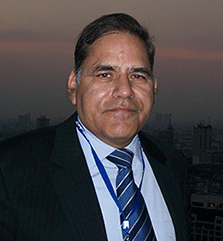HRH Leaders in Action Interview with Shiv Mathur
An interview series with HRH champions in developing countries produced by the HRH Global Resource Center.

Shiv Mathur is a medical doctor and professor who currently serves as the Chair of the Asia Pacific Action Alliance for HRH (AAAH) where he leads efforts to strengthen HRH policy in Asia and Pacific countries. AAAH is an associate partner of CapacityPlus, USAID's flagship global HRH systems strengthening project.
Could you briefly describe the path you took to your current position? How does that background support you as an HRH leader?
In 1975, I was posted as a medical officer at the Rural Health Training Centre of Sawai ManSingh Medical College, Jaipur in India. Our training center covered a cluster of 56 villages, where we were expected to deliver health care and implement national health programmes in a demonstrable manner. This assignment was immediately followed by a posting in an infectious diseases hospital in Jaipur city. Working for more than three years in two contrasting situations in an under-developed state of a developing country gave me an opportunity to conceptualize the principles and practices of the public health while I was still a student. Subsequently working on different faculty positions in the four medical colleges of the state government, I cultivated an insight into the workings of health systems. This was the post Alma-Ata era when health systems around the developing world were struggling to strengthen their primary health care services; and the number of evaluations conducted during this period revealed the weaknesses of health care delivery systems.
It was exciting to work in the United Nations Population Fund's Area Development Project where I led the health management training and research unit which became the State Institute of Health and Family Welfare (SIHFW). Directing the SIHFW over five years was an opportunity to contribute to the process of institution building. You spontaneously get involved in training need assessment when you conscientiously work in such a situation. I am convinced that more than any other component, HRH needs maximum attention from policy makers and top executives.
What is the purpose of the AAAH?
The Asia Pacific Action Alliance on Human Resources for Health (AAAH) is a response to international recognition of the need for global and regional action to strengthen country planning and action on health workforce system. As of January 2013, it has 17 members. The network is pursuing the agenda of HRH advocacy, capacity strengthening, knowledge generation, and technical coordination. Since the Asia-Pacific region holds a major chunk of world’s population, it has unique challenges in delivering health care. AAAH is trying to help its member countries in strengthening their respective health systems through enhancing the capacity of their respective health workforce.
What do you think others - regional groups, governments, and partners expect from AAAH?
AAAH has lucidly indicated its agenda to all its stakeholders. We are trying to cultivate technical know-how on the effectiveness of workforce in health systems. We assume that other regional groups expect us to share with them successes as well as strategies which have not yielded the desired results in this part of the world. We are keen to pursue the interventions with the support of our partners in this region particularly the ones through which our supporters have elicited gains for the countries in other regions of the world. AAAH expects the Governments of all member countries to give a place to the network in helping them strengthen their HRH.
What do you view as your most important lessons learned from your work as part of AAAH?
In less than a decade of its existence, AAAH has proved to be a platform on which experts have exchanged their experience generating a volume of new knowledge. It's a forum where counties with billion-plus population like China and India share their experience with Fiji, PNG, and Samoa etc. Since AAAH is in its formative years, there is a challenge of enhancing its visibility.
What do you see on the road ahead for HRH?
Challenge! Technology is rapidly changing the approach to enhance the capacity of professionals in all sectors including health. Globalization has pervaded in all corners. The quantity and quality in producing health workers needs constant vigilance, particularly when private players create training schools to produce health workers. Since care in sickness always needs compassion, health systems will always be in need of a competent and committed health workforce. Keeping pace with generation of new knowledge and aligning the service delivery systems with recent advances is the path which HRH has to tread.
Past HRH Leaders in Action Interviews
- 1446 reads




